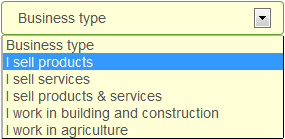You are viewing an old version of this page. View the current version.
Compare with Current View Page History
« Previous Version 4 Next »
https://help.myob.com/wiki/x/ERLq
How satisfied are you with our online help?*
Just these help pages, not phone support or the product itself
Why did you give this rating?
Anything else you want to tell us about the help?
If you've never used MYOB Essentials before, you need to sign up before you can create your first business. To sign up, start by going to the MYOB Essentials website: Australia | New Zealand.
Creating additional businesses? If you've already signed up for MYOB Essentials but want to add a new business to your existing user name, see Using multiple businesses.
The sign in page
On the sign in page, you can sign in if you have an existing MYOB Essentials account. If you need to create a new account, click Sign up for Essentials.
Choosing your business type
Select the business type that best describes what your business does. This will be used to choose the set of default accounts that MYOB Essentials will create for you. Note that you won't be able to change your chosen business type, but you'll be able to edit the accounts list later.

For more information about the default accounts lists for each business type, see Default accounts lists for each business type, below.
When you’re done, click I agree with Terms of Use - Sign me up.
Your business will open, and you’ll be able to set up some of the basic details needed to get started. For more information about these steps, see Basic setup.
All accounts lists provided by MYOB Essentials include the same set of standard accounts, plus some extra accounts tailored for the specific business type. For example, a business that sells products will have a Cost of Sales account for Raw Materials, and a business involved in agriculture will have an expense account for Pesticide.
System accounts
System accounts are required by MYOB Essentials, and will be created even if you choose not to use one of the accounts lists provided by MYOB Essentials. You can’t delete these accounts.
- Asset accounts: ABN withholding credits, Accounts receivable
- Liability accounts: ABN withholdings payable, Accounts payable, GST collected, GST paid, PAYG withholdings payable, Payroll deductions, Superannuation payable
- Equity accounts: Income tax, Historical balancing, Retained earnings, Current year earnings
- Expense accounts: Discounts given, Superannuation expense, Wages & salaries, Discount received.
Standard accounts list
All accounts lists provided by MYOB Essentials include the following accounts, plus additional accounts depending on the business type:
Account type | Accounts included |
|---|---|
| Asset |
|
Liability |
|
Equity |
|
| Expense |
|
Other Income |
|
Other Expense |
|
Additional accounts for each business type
In addition to the standard set of accounts, the accounts list for each business type includes the following accounts:
| Business type | Includes... |
|---|---|
I sell products |
|
I sell services |
|
I sell products & services |
|
I work in building & construction |
|
I work in agriculture |
|

 Yes
Yes
 No
No
 Thanks for your feedback.
Thanks for your feedback.